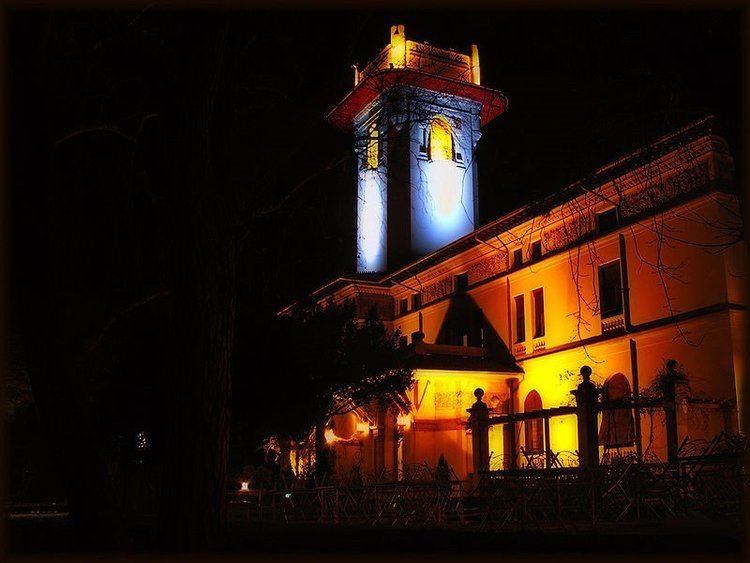Phone +90 216 413 92 53 | ||
 | ||
Address Çubuklu Mah., hidiv Yolu No:32, 34805 Beykoz/İstanbul, Turkey Hours Open today · 9AM–11PMMonday9AM–11PMTuesday9AM–11PMWednesday9AM–11PMThursday9AM–11PMFriday9AM–11PMSaturday9AM–11PMSunday9AM–11PM Similar Küçüksu Palace, Emirgan Park, Ihlamur Palace, Anadoluhisarı, Yıldız Park | ||
The Khedive Palace (Turkish: Hıdiv Kasrı) or Çubuklu Palace (Çubuklu Sarayı), located on the Asian side of the Bosphorus in Istanbul, Turkey, was a former residence of Khedive Abbas II of Egypt and Sudan. The name of the residence is alternatively rendered in English as the Khedive Pavilion or the Khedive Mansion.
Contents
History
Abbas II (reigned 1892–1914) was the last Khedive of Egypt and Sudan. Unlike his predecessors, Abbas II sought cooperative relations with the Ottoman Empire, whose sovereignty over the Khedivate (which continued to be an autonomous vassal of the Ottoman Empire until 1914) had effectively been rendered nominal ever since Muhammad Ali's seizure of power in 1805. Abbas saw this as a potential means of undermining the British occupation (since 1882) of Egypt and Sudan. As part of his efforts at improving relations with the Ottoman Porte, Abbas made several visits to the Ottoman capital Istanbul, and commissioned Italian architect Antonio Lasciac (1856–1946) assisted by Delfo Seminati, to build a summer residence at the Bosphorus.
The palace, completed in 1907, was designed in the Art Nouveau style, mainly inspired by Italian villas of the Renaissance era, incorporating characteristics and details of neo-classical Ottoman architecture.
The palace stands on a hilltop within a large grove of some 270 acres (110 ha) above the Çubuklu neighborhood in the Beykoz district, overlooking the Istanbul Strait.
Surrounded by marble terraces, the three-story building's east front is square, and the south and northwest sides are crescent-shaped. A unique feature of the structure is a high tower. A monumental fountain at the main entrance rises all the way to the roof. In the surroundings of the residence, there are other fine fountains and pools. The rose garden of the residence is the largest in Istanbul.
At the ground floor of the 1,000 m2 (11,000 sq ft) palace, several rooms and halls encircle a central hall, which helps connect them with each other. A large hall at the ground level has a fireplace. At the upper floor, two big bedrooms exist. The terrace on top of the building is accessible also by a historic steam-operated elevator. The building is covered from floor to ceiling in stained glass.
The interior is decorated with neo-classical, neo-Islamic and neo-Ottoman features. The capitals of the marble pillars, walls and ceilings are embroidered with figures of flowers, fruit and hunting animals reflecting the effects of European architecture. The outer gate of the building is completely depicted with gilded flower figures.
Abbas' unofficial and secret second wife, Cavidan Hanım (Lady Djavidan or originally Hungarian May Countess Torok von Szendro), claims in her memoirs "Harem" that she decided in all phases of the palace's creation from scratch to the selection of the elements for the interior design. She also assigned the layout of the palace gardens, including the re-planted trees, rose garden and the winding footpaths in the woods.
An identical copy of the palace was built on the shore of the Nile in Egypt.
Modern use
On the behest of Mustafa Kemal Atatürk, the founder and first President of Turkey, the City of Istanbul purchased the palace in 1937. However, it remained neglected until the 1980s.
The Touring and Automobile Club of Turkey (TTOK) signed an agreement in 1979 with the Municipality of Istanbul to restore and manage some Ottoman imperial parks and historic sites in Istanbul for tourism. Within this framework, the institution, under its director general Çelik Gülersoy, restored the neglected palace within the next two years. In 1984, the Khedive Palace opened to the public.
The inner halls were used as a restaurant, the upper levels as a hotel, and the marble hall and gardens surrounding the residence as cafés. The residence can host meetings of up to 1000 people in summer, with cocktail facilities of up to 1500. In winter months, it can accommodate up to 450 people and cocktails for 700.
The premises were managed by the TTOK for ten years, and were then taken over in 1994 by the Istanbul Metropolitan Municipality, because the Municipality did not renew its agreement with the TTOK. The hotel facility is now closed.
